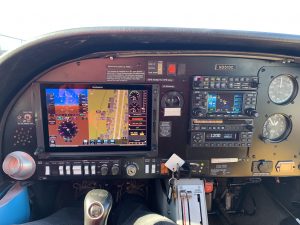 5 ways a “glass cockpit’ improves a pilot’s flight training
5 ways a “glass cockpit’ improves a pilot’s flight training
Instructors at Crosswinds Aviation like to talk to aspiring pilots about “staying ahead of the plane,” but it generally draws quizzical looks until the comment is explained more fully.
The idea, according to Crosswinds owner Matt Dahline, is about getting your job as a pilot done as efficiently as possible and being prepared for the next thing that is going to happen or the next task that needs to be performed.
“The background of all of this is safety,” Dahline said. “As a pilot, you want to be in a position of being ready to make your next move. The more you have to react to something, the more you’re behind on flying the aircraft safely.”
Two of the key advantages of pilot training at Crosswinds is that all flight students learn using a “glass cockpit” and in modern planes. Most flight schools are still using aircraft from the 1970s and 1980s and the outdated gauge mechanisms that identify flying conditions.
The glass cockpit, using Garmin’s G1000 and G500 product suite, is a package of software and computerized displays that make flight information easier to scan and process. It increases pilots’ awareness and ability to properly fly an aircraft.
Flight critical data is readily displayed rather than an estimate of a reading. The readily available information includes flight instrumentation, navigation, weather, terrain, traffic and engine data on large-format, high-resolution displays.
Dahline stresses that the technology is not a substitute for technical flying ability. Instead, it’s a method of making life easier, and reducing the mental strain when flying so pilots can be alert and aware.
“Students still have to learn the fundamentals of flying,” he said. “We’re not teaching pilots to be button-pushers, we’re just learning with modern tools.”
He draws an analogy of a carpenter building a chair. The carpenter still needs the fundamental skills of how to cut the wood, at the correct angles and how to effectively secure the pieces. You can certainly get the job done with hand tools. However, with modern power tools you can build a better chair and much faster. The same concept applies to flying an aircraft. Modern avionics ultimately reduce workload while at the same time giving the pilot much more information at their disposal to make decisions.
Here are 5 advantages of flying with a glass cockpit:
Attitude and situational Awareness: For those flying under instrument conditions, there is nothing better than having a huge artificial horizon behind all your primary flight instruments. This alone reduces workload significantly with your instrument scan. In addition, having a large representation of where you are on an aeronautical chart leaves little work for navigation.
Interpretation: The layout of the data allows pilots to more quickly interpret flight conditions.
Weather reports: Current conditions, forecasts, radar, winds aloft and satellite imagery are right at a pilot’s fingertips.
Precision: There’s less time spent interpreting the altimeter’s needles or position of the airspeed indicator. Pilots have actual numbers and values on the screen.
Automation: There are a number of mundane tasks that pilots have historically had to manage manually like constantly monitoring and setting the heading indicator, entering instrument procedures, identifying VOR’s, finding nearest airports, and the list goes on. Many of these tasks have been fully automated.
